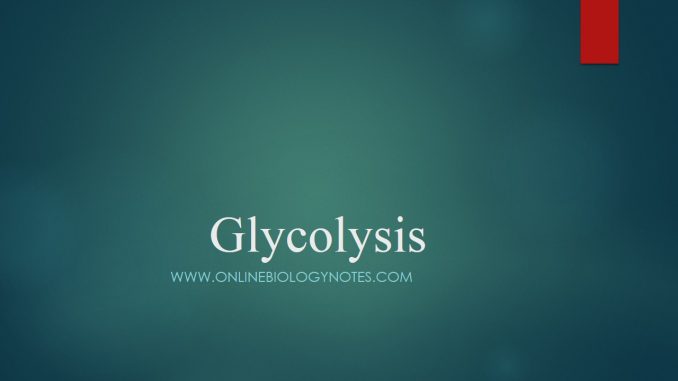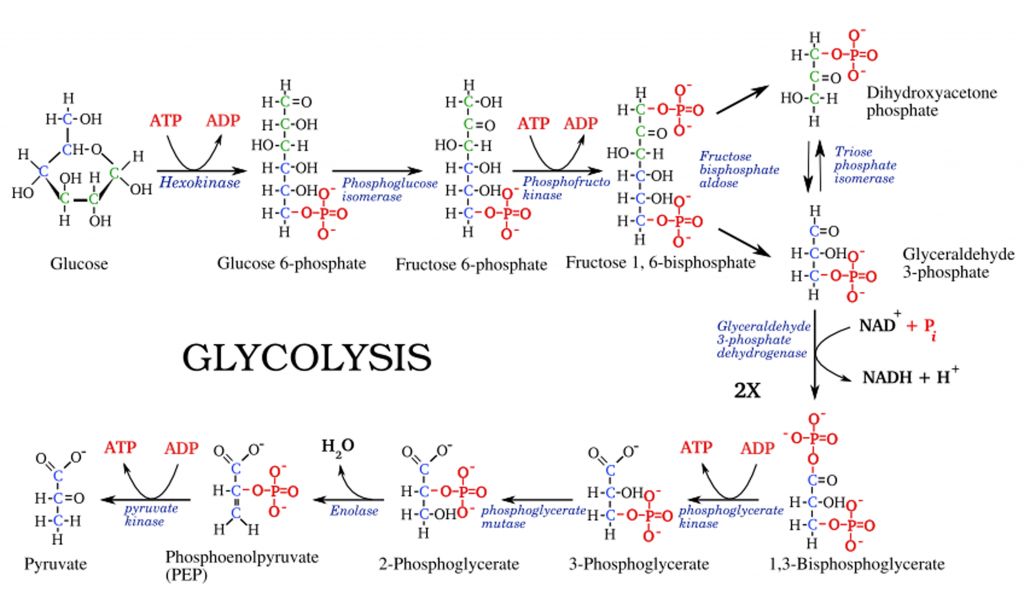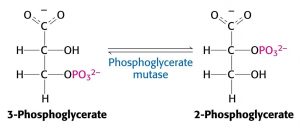
Glycolysis: steps, diagram and enzymes involved
- Glycolysis is the process of enzymatic break down of a glucose molecule into two pyruvate molecule.Pyruvate is a 3-carbon compound.
- During glycolysis some of the free energy is released and conserved in the form of ATP and NADH.
- Glycolysis is an almost universal central pathway of glucose catabolism.
- Glycolytic breakdown of glucose is the sole source of metabolic energy in some mammalian tissues and cells (RBCs, Brain, Renal medulla and Sperm cell).
- Anaerobic microorganisms are entirely dependent on glycolysis.

Glycolysis occurs in TEN steps.
Glycolysis consists of series of 10 enzyme catalyzed reactions which are divided into two phases.
- Preparatory phases
- Payoff phase
1. Preparatory phase:
In preparatory phase glucose molecule is activated for breakdown and energy is invested in the process of phosphorylation of glucose. The first five reactions constitutes the preparatory phase.
Step I: Phosphorylation of glucose

Glucose is phosphorylated at –OH group of C6 in which one molecule ATP is consumed. The reaction is catalyzed by the enzyme Hexokinase in the presence of Mg++ ion.
Step II: Isomerization of glucose-6 phosphate to fructose-6- Phosphate
 This reaction is catalyzed by the enzyme phosphoglucose isomerase.
This reaction is catalyzed by the enzyme phosphoglucose isomerase.
Step III: Phosphorylation of fructose-6-phosphate

This reaction is catalyzed by Phospho-fructo-kinase (PFK) in the presence of Magnesium ion, in which fructose-6-phosphate is converted into fructose-1,6-bisphosphate. One molecule of ATP is consumed.
Step IV: Cleavage of Fructose-1,6-bisphosphate

The enzyme Aldolase (fructose-1,6-diphosphate aldolase) cleave fructose-1,6-bisphosphate to yield two molecule glyceraldehyde-3-phosphate and dihydroxy-acetone phosphate.
Step V: Conversion of dihydroxy-acetone phosphate to glyceraldehyde-3-phosphate.

Dihydroxy-acetone phosphate and glyceraldehyde-3-phosphate are isomers. The reaction is catalyzed by the enzyme triose phosphate isomerase.
2. Payoff phase:
In payoff phase oxidation of glucose releases energy in the form of ATP and NADH. The remaining five reactions constitutes payoff phase
Step VI: Oxidation of glyceraldehyde-3-phosphate:

The glyceraldehyde-3-phosphate is oxidized into 1,3-bisphospho-glycerate in the presence of enzyme glyceraldehyde-3-phosphate dehydrogenase (GAPDH). In this reaction one molecule of NADH is released.
Step VII: Transfer of phosphoryl group from 1,3-bisphosphoglycerate to ADP

The enzyme phosphoglycerate kinase (PGK) transfer phosphoryl group from 1,3 bisphosphate glycerate to ADP forming ATP and 3-phospholycerate. This reaction is an example of substrate level phosphorylation in which phosphoryl group is transfer from substrate ie 1,3-bisphosphoglycerate to ADP to form ATP.
Step VIII: Conversion of 3-phosphoglycerate to 2-phoshoglycerate

The enzyme phosphoglycerate mutase catalyses reversible shift of phosphoryl group between C2 and C3 of phosphoglycerate. Mg++ is essential for this reaction.
Step IX: Dehydration of 2-phosphoglycerate (Removal of H2O from 2-phosphoglycerate)

Enolase promote reversible removal of a molecule of water from 2-phosphoglycerate forming Phosphoenol-pyruvete (PEP).
Step X: Transfer of phosphoryl group from PEP to ADP

This reaction is catalyzed by the enzyme pyruvate kinase in the presence of K+ and Mg++ or Mn++ions. This is also a substrate level phosphorylation in which phosphoryl group is transferred from PEP to ADP forming ATP and Pyruvate. In this substrate level phosphorylation, the product pyruvate first appears in its enol form which then tautomerize rapidly and non-enzymatically to its keto form.
Thermodynamics of Glycolysis:
In glycolysis, one molecule of glucose is break down into two molecules of pyruvate releasing 2 ATP and 2 NADH. The overall equation of aerobic glycolysis is
Glucose + 2NAD+ 2ATP +2Pi ————— 2pyruvate + 2ADP +2NDAH +2H2O + 2H+
Conversion of glucose to pyruvate is an exothermic reaction with net free energy of
ΔG= -85KJ/mole
Resolving above equation into two equations.
1. Formation of NADH is exothermic
Glucose + 2NAD+ —————– 2pyruvate + 2NDAH +2H2O + 2H+
ΔG1= -146KJ/mole
2. Formation of ATP is endothermic reaction
2ADP +2Pi————— 2ATP + 2H2O
ΔG1= +61KJ/mole
Net free energy= -146+61= -85KJ/mole
Regulation of glycolysis:
The reaction catalyzed by Phosphofructose kinase is the rate limiting step or control point of glycolysis. However glycolysis is regulated by two mechanism.
1. Allosteric regulation:
ATP and citrate are allosteric inhibitor of phosphfructo kinase. Therefore glycolysis stops in cell having large amount of ATP and citrate (High energy condition). AMP and ADP are allosteric activator and they get accumulated in cell when energy content is depleted.
2. Reciprocal regulation:
Fructose-2,6 bisphosphate is potent activator of phosphofructose kinase while Fructose-1,6-bisphosphate is inhibitor of phosphofructose kinase. Increased concentration of fructose-1,6-bisphosphate favor formation of glucose from pyruvate (gluconeogenesis).
